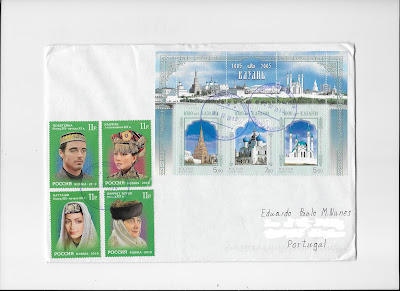Sunday 16 July 2023
RUSSIA
A cover from Russia, depicting a complete set of 3 stamps celebrating the millenium of Kazan and with several pictures of Kazan Kremlin. The Kazan Kremlin is the chief historic citadel of Russia, situated in the city of Kazan. Built on an ancient site, the Kazan Kremlin dates from the Muslim period of the Golden Horde and the Kazan Khanate. It was conquered by Ivan the Terrible in 1552 and became the Christian See of the Volga Land. The only surviving Tatar fortress in Russia and an important place of pilgrimage, the Kazan Kremlin consists of an outstanding group of historic buildings dating from the 16th to 19th centuries, integrating remains of earlier structures of the 10th to 16th centuries.It was declared a World Heritage Site in 2000.
Saturday 8 July 2023
NORFOLK ISLAND
My first cover from Norfolk, depicting 3 complete sets on a total of 6 different stamps. Norfolk Island is an external territory of Australia located in the Pacific Ocean between New Zealand and New Caledonia, 1,412 kilometres directly east of Australia's Evans Head and about 900 kilometres from Lord Howe Island. Together with the neighbouring Phillip Island and Nepean Island, the three islands collectively form the Territory of Norfolk Island.
At the 2021 census, it had 2,188 inhabitants living on a total area of about 35 km2. Its capital is Kingston. The postage stamps and postal history of Norfolk Island depended on Australia until 1947, when the island, an Australian territory since 1914, received its own stamps and a postal autonomy.
BRAZIL
This cover from Brazil depicts 2 different stamps. The stamp on the bottom celebrates the Itatiaia National Park, a part of the UNESCO World Heritage Site Atlantic Forest South-East Reserves, in the states of Paraná and São Paulo. The 25 protected areas that make up the site (some 470,000 ha in total) display the biological wealth and evolutionary history of the last remaining Atlantic forests. From mountains covered by dense forests, down to wetlands, coastal islands with isolated mountains and dunes, the area comprises a rich natural environment of great scenic beauty. It was declared a Natural World Heritage Site by UNESCO in 1999.
LITHUANIA
This cover from Lithuania depicts a miniature sheet showing a historical building in Vilnius, the capital of Lithuania. The Old Town of Vilnius, one of the largest surviving medieval old towns in Northern Europe, has an area of 3.59 square kilometres. It encompasses 74 quarters, with 70 streets and lanes numbering 1487 buildings with a total floor area of 1,497,000 square meters. It was founded by the Lithuanian Grand Duke and King of Poland Jogaila in 1387 on the Magdeburg rights the oldest part of the Lithuanian capital of Vilnius, it had been developed over the course of many centuries, and has been shaped by the city's history and a constantly changing cultural influence. It is a place where some of Europe's greatest architectural styles—gothic, renaissance, baroque and neoclassical—stand side by side and complement each other. There are many Catholic, Lutheran and Orthodox churches, residential houses, cultural and architectural monuments, museums in the Old Town. In 1994 the Vilnius Old Town was included as a UNESCO World Heritage Site in recognition of its universal value and originality. It has been recognised as one of the most beautiful cities of the Old Continent that also has the largest baroque Old Town in the whole of Eastern and Central Europe.
Subscribe to:
Posts (Atom)






